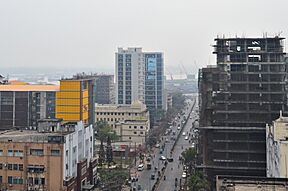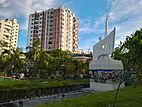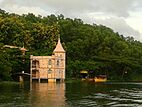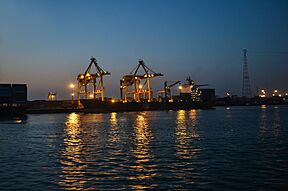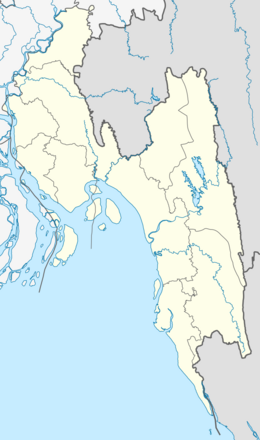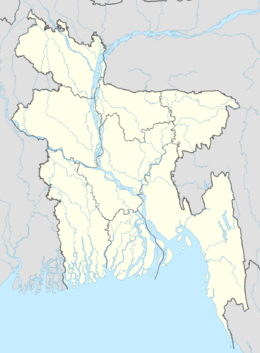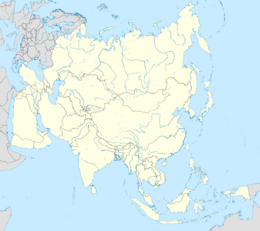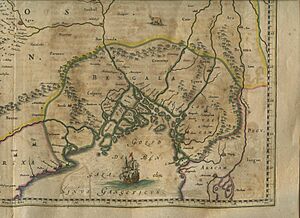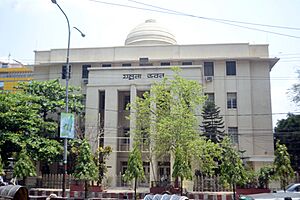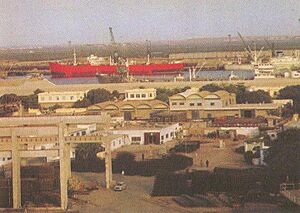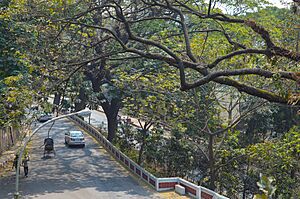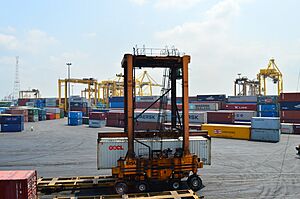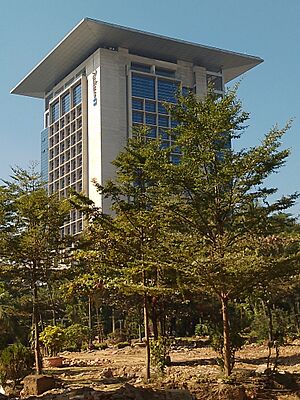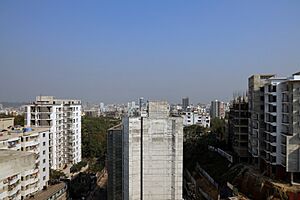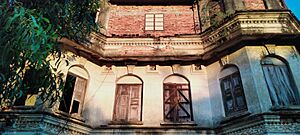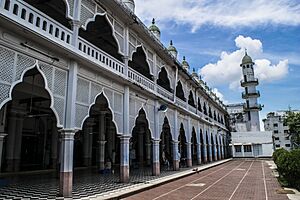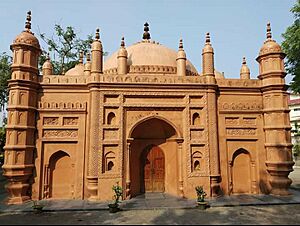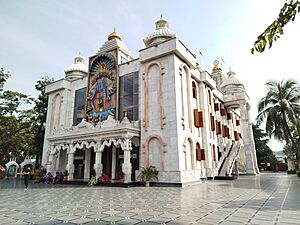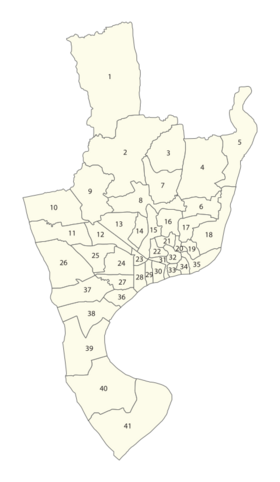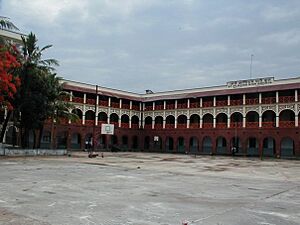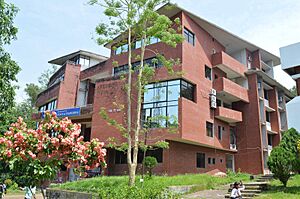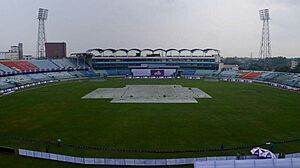Chittagong facts for kids
Quick facts for kids
Chittagong
চট্টগ্রাম
|
|
|---|---|
| Chattogram | |
|
Sheikh Mujib Road
Biplob Udyan
Foy's Lake
Patenga
Jamboree Park
Port of Chittagong
|
|
| Nickname(s):
Queen of the East
Commercial Capital of Bangladesh Land of twelve Sufi saints |
|
| Country | |
| Division | Chittagong |
| District | Chittagong |
| Establishment | 1340 |
| Granted city status | 1863 |
| Government | |
| • Type | Mayor–Council |
| • Body | Chattogram City Corporation |
| Area | |
| • City | 168.07 km2 (64.89 sq mi) |
| • Urban | 272.03 km2 (105.03 sq mi) |
| • Metro | 655.74 km2 (253.18 sq mi) |
| Elevation | 29 m (95 ft) |
| Population
(2022 census)
|
|
| • City | 3,230,507 |
| • Density | 32,008/km2 (82,900/sq mi) |
| • Metro | 5,513,609 |
| • City rank | 2nd in Bangladesh |
| • Metro rank | 2nd in Bangladesh; 3rd in Bengal Region; |
| Demonym(s) | Chittagonian, Chatgaiya, Chitainga |
| Languages | |
| • Official | Bengali • English |
| Time zone | UTC+6 (BST) |
| Postal code |
4000, 4100, 42xx
|
| Calling code | +880 31 |
| UN/LOCODE | BD CGP |
| HDI (2019) | 0.654 medium |
| Police | Chattogram Metropolitan Police |
| International Airport | Shah Amanat International Airport |
| Metropolitan Planning Authority | Chittagong Development Authority |
| Water Supply and Sewerage Authority | Chattogram WASA |
| Website | ccc.gov.bd |
Chittagong (also known as Chattogram) is the second-largest city in Bangladesh. It's famous for the Port of Chittagong, which is the busiest port in Bangladesh and the Bay of Bengal. The city is located on the Karnaphuli River, nestled between the Chittagong Hill Tracts and the Bay of Bengal. In 2022, the Greater Chittagong Area had over 5.2 million people. Chittagong is a major hub for businesses and plays a big part in Bangladesh's economy.
This city has one of the world's oldest natural harbors. It even appeared on ancient Greek and Roman maps! In the 9th century, merchants from the Abbasid Caliphate set up a trading post here. Later, in the 14th century, it became part of the Muslim kingdom of Bengal. For a long time, Chittagong was a busy center for trade and shipping. From the 15th to 17th centuries, it was also important for the region of Arakan. In the 16th century, it became a Portuguese trading post. The Portuguese were later expelled by the Mughal Empire in 1666.
In 1793, the British East India Company took control of the port. It became a "Major Port" of British India in 1928. During World War II, Chittagong was an important base for the Allied Forces. After the Partition of British India in 1947, the city grew and became a key industrial area. In 1971, during the Bangladesh Liberation War, the Bangladeshi Declaration of Independence was announced from Chittagong. Today, the city continues to grow with many industries and businesses.
Chittagong is very important to Bangladesh's economy. It accounts for 12% of the country's total economic output. This includes 40% of industrial production and 80% of international trade. The city is home to many large companies. The Bangladesh Navy's biggest base is here, along with an air base and army garrisons. Chittagong is also known for its diverse population, with many different religions and ethnic groups living together.
Contents
About the Name
The exact origin of the name Chittagong is not fully known. Over time, the city has been called by many names, like Chatigaon, Chatigam, Chattagrama, and Islamabad.
The Bengali name for Chittagong is Chattogram. Some believe the name comes from early records that describe it as a place with many Buddhist monasteries. The city had a large Buddhist population before Islam arrived. During the Mughal era, it was renamed Islamabad, meaning "City of Islam". This name is still used in the old part of the city.
A Look at History
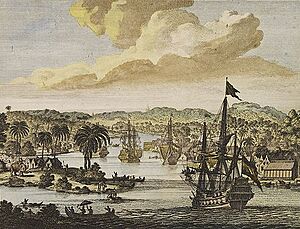
Chittagong has been inhabited since the Stone Age. It is a very old port city, with records going back to the 4th century BC. Ancient maps, like Ptolemy's world map from the 2nd century, mentioned its impressive harbor. The region was once part of ancient Bengali kingdoms.
- Early Trade and Islam: Arab Muslim traders visited Chittagong starting in the 9th century. In 1154, a writer named Al-Idrisi mentioned a busy shipping route connecting Chittagong with Baghdad. Many Sufi missionaries came to Chittagong and helped spread Islam.
- Under the Sultans: In 1340, Sultan Fakhruddin Mubarak Shah conquered Chittagong, making it part of the Bengal Sultanate. This made it the main sea gateway to one of the richest states in the Indian subcontinent. Chittagong was a center for trade with China, Sumatra, the Maldives, and the Middle East. It was known for trading pearls, silk, and gunpowder. The port was also a major place for shipbuilding. Famous travelers like Ibn Battuta and Niccolò de' Conti visited the city.
- Portuguese Influence: In 1528, the Bengal Sultanate allowed the Portuguese to set up a trading post in Chittagong. This was the first European settlement in Bengal. The Portuguese controlled the port for over a century. They introduced a system where ships had to buy trading licenses from them. Slave trade and piracy also became common.
- Mughal Rule: In 1666, the Mughal government, led by Shaista Khan, took Chittagong back from the Portuguese and Arakanese. The Mughals attacked with a large army and navy. After a three-day battle, the Arakanese surrendered. The Mughals renamed the city Islamabad. This period brought economic growth and new buildings, like Fort Ander and many mosques. Shipbuilding also increased greatly.
- British Era: The British East India Company took full control of Chittagong in 1793. Railways were built in 1865, connecting Chittagong to other major cities. The port became the main gateway to Eastern Bengal and Assam, handling goods like tea, jute, and oil.
- Freedom Struggle: The Chittagong armoury raid in 1930 was a big event in India's fight for independence from British rule.
Chittagong in World War II
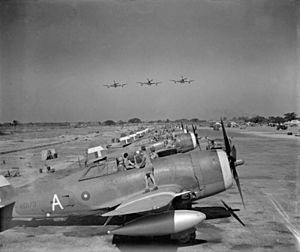
During World War II, Chittagong was a frontline city. It served as a vital air, naval, and military base for the Allied Forces fighting against Japan. The Japanese Air Force bombed Chittagong in 1942.
After the Battle of Imphal, the Allies started winning. Units of the United States Army Air Forces were stationed at Chittagong Airfield in 1945. The war caused many problems, including a rise in refugees and the Bengal famine of 1943.
Today, 715 soldiers are buried at the Chittagong War Cemetery. It is a place where people remember the soldiers who died in the war.
Modern Chittagong
After the Partition of British India in 1947, Chittagong became the main port of East Pakistan. The Chittagong Tea Auction was set up in 1949. Many wealthy families and companies moved their headquarters to Chittagong. Industries like jute, textiles, and steel grew.
During the Bangladesh Liberation War in 1971, Chittagong saw heavy fighting. The Bangladeshi Declaration of Independence was broadcast from Kalurghat Radio Station in Chittagong. After the war, the Soviet Union helped clear mines from Chittagong Port. The city quickly became a major port again.
In the late 1970s, Chittagong became home to Bangladesh's first export processing zones. The city has seen many new projects, including the first underwater tunnel in South Asia, the Bangabandhu Sheikh Mujibur Rahman Tunnel. Chittagong is a key part of Bangladesh's growing economy.
City Geography
Chittagong is located in southeastern Bangladesh. It sits among the coastal hills of the Chittagong Hill Tracts. The Karnaphuli River flows along the southern part of the city. The river meets the Bay of Bengal about 12 kilometers west of downtown.
The highest point in Chittagong District is Mount Sitakunda, at 351 meters. Within the city, Batali Hill is the highest, at 85.3 meters. Chittagong has several lakes, including Foy's Lake, which was created in 1924.
- Natural Beauty: The Chittagong Division is known for its rich biodiversity. It has over 2000 types of flowering plants. The hills and jungles have waterfalls, rivers, and elephant reserves. St. Martin's Island, nearby, is the only coral island in Bangladesh. Cox's Bazar has one of the world's longest natural beaches.
- Climate: Chittagong has a tropical monsoon climate. This means it has hot, rainy summers and mild, dry winters. The city is sometimes affected by tropical cyclones. The deadliest one was the 1991 Bangladesh cyclone, which caused a lot of damage.
Economy and Business
| Top publicly traded companies in Chittagong, in 2014 |
|||||
| Jamuna Oil Company | |||||
| BSRM | |||||
| Padma Oil Company | |||||
| PHP | |||||
| Meghna Petroleum | |||||
| GPH Ispat | |||||
| Aramit Cement | |||||
| Western Marine Shipyard | |||||
| RSRM | |||||
| Hakkani Pulp & Paper | |||||
| Source: Chittagong Stock Exchange |
|||||
Chittagong contributes a lot to Bangladesh's economy. It makes up 12% of the country's total economic output. The city produces 40% of Bangladesh's industrial goods and handles 80% of its international trade.
The Port of Chittagong handled $60 billion in trade in 2011. It is one of the busiest ports in South Asia. The port is also part of the Maritime Silk Road, a trade route connecting China to Europe.
Many large companies have their main offices in Chittagong. Key industries include petroleum, steel, shipbuilding, chemicals, and textiles. The Chittagong Export Processing Zone is a special area that attracts foreign investments. The Chittagong Tea Auction sets the price for Bangladeshi tea.
Chittagong is often called Bangladesh's commercial capital. It aims to become a global financial center and a major shipping hub for the region.
City Architecture
Chittagong has many interesting buildings from different time periods. The Anderkilla Shahi Jame Mosque is a famous Mughal building. It was built in 1667 and is the only remaining part of a Mughal fort. The Kadam Mubarak Mosque was built in 1723.
During British rule, officials lived in beautiful hilltop bungalows. These houses often had large balconies and gardens. Famous British-era buildings include the Battali Railway Station and the Chittagong Court Building.
Later, buildings like the Ispahani Building and the Jamuna Oil Company headquarters were built in the Art Deco style, popular in the 1930s.
Culture and Traditions
People from Chittagong are called Chittagonian. For centuries, the city has been a "melting pot" of different cultures. Its history of trade has influenced its language, culture, and food. The Chittagonian language is spoken here.
A popular traditional feast is Mezban, where a hot beef dish is served with rice. Another famous dish is kala-bhuna, a special beef curry. Chittagong is also known for its historic pink pearl cultivation.
The city is called the Land of the Twelve Saints because of its many Sufi Muslim shrines. Sufism played a big role in spreading Islam in the region. Famous shrines include those of Shah Amanat and Bayazid Bastami. The Bastami shrine has a pond with rare black softshell turtles.
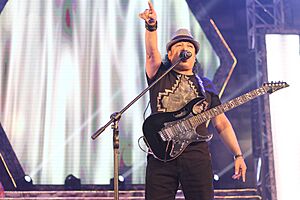
Chittagong is home to important Hindu temples, like the Chandranath Temple. It also has Bangladesh's largest Buddhist monastery. The Roman Catholic Diocese of Chittagong is the oldest Catholic mission in Bengal.
The city has a lively art scene. It is also known as the "birthplace of Bangladeshi rock music", with famous bands like Souls and LRB starting here.
Population and People
| Historical population | ||
|---|---|---|
| Year | Pop. | ±% |
| 1931 | 53,156 | — |
| 1941 | 92,301 | +73.6% |
| 1991 | 1,392,958 | +1409.1% |
| 2001 | 2,023,489 | +45.3% |
| 2011 | 2,582,401 | +27.6% |
| 2022 | 3,227,246 | +25.0% |
| sources:citypopulation.de | ||
In 2011, Chittagong had over 2.5 million people. By 2022, the city's population grew to more than 3.2 million. Most people in Chittagong are Muslims. There are also many Hindus, Buddhists, and Christians.
Chittagong has always been a mix of different ethnic groups. Muslim immigrants arrived as early as the seventh century. Many Muslim traders and preachers from Persia and Arabia settled here. The city also has ethnic minorities from the nearby hills, like Chakmas and Tripuris. The Bengali-speaking Theravada Buddhists are one of the oldest communities in Chittagong. Descendants of Portuguese settlers, called Firingis, also live here.
Media and Communication
Chittagong has many newspapers, including daily papers like Dainik Azadi and The Daily Suprobhat Bangladesh. There are also weekly and monthly newspapers. The Chittagong Press Club is the main press council.
Government-owned Bangladesh Television and Bangladesh Betar have stations in the city. Chittagong has been featured in many Bangladeshi movies, TV shows, and songs. The Bollywood film Khelein Hum Jee Jaan Sey is based on the 1930s Chittagong Uprising.
City Services
The Bangladesh Power Development Board provides electricity to Chittagong. Fire services are handled by the Bangladesh Fire Service & Civil Defence. The city uses about 1000 megawatts of electricity.
The Chattogram WASA manages the water supply and sewage systems. Water comes mainly from the Karnaphuli River and is cleaned at the Mohra Purification Plant.
Chittagong has good mobile phone coverage from all major operators. Landline phone and internet services are also available.
City Administration
Chattogram is divided into 16 areas called thanas. These thanas are further divided into 41 wards and 211 mahallas. The 41 wards are managed by elected representatives under the Chattogram City Corporation.
| serial no. | Ward Name |
|---|---|
| 1 | South Pahartali |
| 2 | Jalalabad |
| 3 | Panchlaish |
| 4 | Chandgaon |
| 5 | Mohra |
| 6 | East Sholashahar |
| 7 | West Sholashahar |
| 8 | Sholokbahar |
| 9 | North Pahartali |
| 10 | North Kattali |
| 11 | South Kattali |
| 12 | Saraipara |
| 13 | Pahartali |
| 14 | Lalkhan Bazar |
| 15 | Bagmaniram |
| 16 | Chawkbazar |
| 17 | West Bakalia |
| 18 | East Bakalia |
| 19 | South Bakalia |
| 20 | Dewan Bazar |
| 21 | Jamal khan |
| 22 | Enayet Bazar |
| 23 | North Pathantooly |
| 24 | North Agrabad |
| 25 | Rampur |
| 26 | North Halishahar |
| 27 | South Agrabad |
| 28 | Pathantooly |
| 29 | West Madarbari |
| 30 | East Madarbari |
| 31 | Alkaran |
| 32 | Andarkilla |
| 33 | Firingee Bazar |
| 34 | Patharghata |
| 35 | Boxirhat |
| 36 | Gosaildanga |
| 37 | North Middle Halishahar |
| 38 | South Middle Halishahar |
| 39 | South Halishahar |
| 40 | North Patenga |
| 41 | South Patenga |
Education and Learning
Chittagong's education system is like the rest of Bangladesh. There are four main types of schools:
- General Education: Follows the national curriculum in Bengali and English. Students take SSC and HSC exams.
- Madrasah Education: Focuses on Islamic studies, with other subjects included. Students take Dakhil and Alim exams.
- English Medium Schools: Private schools that follow the General Certificate of Education (O Levels and A Levels).
- Technical and Vocational Education: Provides training for specific jobs.
Chittagong College, founded in 1869, is the oldest higher education institution. The University of Chittagong is one of the largest universities in Bangladesh. There is also the Chittagong University of Engineering and Technology, a leading engineering university.
The city has several private universities and medical colleges.
Getting Around Chittagong
Transport in Chittagong is similar to Dhaka. The city has large roads, buses, and taxi services. You can also find smaller 'baby' or 'CNG' taxis, which are motor vehicles with three wheels. Traditional manual rickshaws are also very common. Ride-sharing apps like Uber and Pathao are available too.
- Roads: The N1 (Dhaka-Chittagong Highway) is the main road connecting Chittagong to other parts of the country. It has been upgraded to four lanes. The city is also building a 9.3 km underwater expressway tunnel under the Karnaphuli River. This will be the first of its kind in South Asia.
- Trains: Chittagong has two main railway stations. You can take trains to Dhaka, Sylhet, and other cities. The Chittagong Circular Railway was started in 2013 to help with city traffic.
- Air Travel:
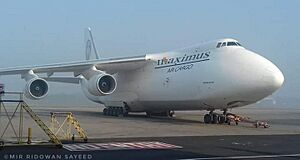 An Antonov An 124 parked at Shah Amanat International Airport.
An Antonov An 124 parked at Shah Amanat International Airport.
The Shah Amanat International Airport is Chittagong's only airport. It is the second busiest airport in Bangladesh. During World War II, it was known as Chittagong Airfield. Today, it has flights to cities in the Middle East and Kolkata, India. All Bangladeshi airlines also offer domestic flights to Dhaka. The airport was renamed after a famous Sufi saint, Shah Amanat, in 2005.
Sports in Chittagong
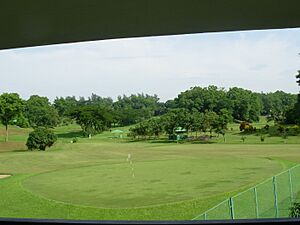
Chittagong has produced many talented cricketers and footballers. Cricket is the most popular sport here, but football, tennis, and kabaddi are also well-liked.
The main stadium is the multipurpose MA Aziz Stadium, which can hold 20,000 people. It hosts football matches. The Zohur Ahmed Chowdhury Stadium is the main cricket venue. It has hosted international cricket matches, including games for the 2011 Cricket World Cup and 2014 ICC World Twenty20.
Major sports clubs in the city include Mohammedan Sporting Club and Abahani Chittagong. Chittagong is also home to the Bangladesh Premier League cricket team, the Chattogram Challengers.
Sports Teams
- Chattogram Challengers – BPL (Cricket)
- Chittagong Abahani Limited – BPL (Football)
- Acme Chattogram – HCT (Field hockey)
Sister Cities
Chittagong has special connections with these cities:
Images for kids
-
Hilltop mansions and bungalows historically dominated Chittagong's skyline.
See also
 In Spanish: Chittagong para niños
In Spanish: Chittagong para niños


